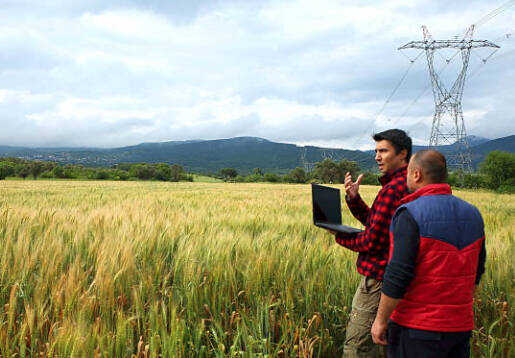TOP STORY OF THE DAY: FCC says Clay County 'broadband ready,' but is it?

Internet availability is quickly becoming an issue in rural areas of Indiana, made painfully apparent by the not-so-distant COVID-19 pandemic and its many effects.
Complicating the matter more is the Federal Communications Commission’s (FCC) rating for current broadband connectivity, which shows Clay County as being “broadband ready” — that is, that the county currently has the infrastructure necessary to provide download and upload speeds at 25 and 3 megabits per second, respectively, for all residents.
Though some internet providers in Clay County are working at these speeds in rural areas, the word from those living outside of Brazil — including residents of small towns — is starkly different from the FCC’s designation.

Clay County Commissioner Marty Heffner is one such rural resident who has noticed some troubling signs concerning his internet connectivity and how soon it may be remedied.
“My address is awful. It’s supposed to be 25 megabits, mine is like 3.5. But when you go on the FCC website to see what the availability is in your area, they show my address as green, or ‘broadband ready’ at 25 MBps,” he explained Wednesday during a meeting at the Clay County courthouse with key players in Clay County productivity: Tiffany Ludwig, president of Clay County Indiana Farm Bureau; Sarah Froderman, West Central Community liaison for the Office of Community & Rural Affairs (OCRA); and Brook Reinoehl, president of the Clay County Chamber of Commerce.
“They even show my parents, who’ve had several people out there trying to get them broadband, and they all tell them ‘you have nothing here,’ yet (the FCC) shows them rated as green,” Heffner said.
According to statistics learned by Heffner and other commissioners throughout the state during a fall conference in Indianapolis, hosted by the Indiana Association of County Commissioners, the state has approximately $63M of federal funds dedicated to expanding broadband capability in 2023.
However, grants awarded to county and city agencies to expand broadband in their areas rely on the ratings provided by the FCC, therefore potentially blocking Clay County from ever receiving any portion of the available funds.
Heffner added that internet “speed tests” are widely available to the public, and an official speed test is available through Farm Bureau, and emplores residents to update their address on the map.
“The only way we can increase the amount of money that comes to Clay County is to do this broadband test and to challenge the FCC,” Heffner said.
The results of the test (available at www.infb.org/speedtest), taken by individual residents, are then used to create a more accurate map of actual broadband capability.
“The more addresses we can challenge, the better. Obviously, we know we’re not broadband ready. A lot of places are, and we’re working hard in order to get the county to that point,” Heffner said. “This last year, through grants and different things, we brought over $6.5M into the county for broadband, but a lot of those projects aren’t going to be complete until 2024.”
Charter Communications, a local internet and television provider, is already hard at work installing necessary infrastructure, such as underground fiber-optic lines. The company received just under $1M to cover 700 homes in Clay County with broadband services by 2024, via a grant through the federal Rural Digital Opportunity Fund.
Additionally, the company is requesting $2.7M from OCRA to cover a further 241 homes.
But with tens of thousands of residents in Clay County, many of whom experience similar incapabilities as Heffer, the surface is only being scratched.
“What will really make the biggest difference is if the residents start taking these tests and start getting themselves on the map,” OCRA’s Froderman said. “The commissioners are doing everything they can but it’d be really advantageous for the residents to start participating in these programs and test, so that their addresses are out there and they can get more attention out there.”
Once a resident performs a speed test through Farm Bureau, the data is collected and populated into an accurate map, which is then submitted to the FCC.
“A lot of our members are rural, and we need this just as much, if not more,” Farm Bureau’s Ludwig said, noting farming processes which use internet-relient tech to not only perform their tasks but to quickly order new parts and equipment.
“A lot of the service is along (Interstate) 70, or right here in town. Anywhere outside of that, you’re not seeing much,” she continued. “The more technology that farms get and people can have at home — we need it. I had three kids during COVID, in school. That was fun. We took shifts doing school work.”
The pandemic had an especially harmful impact on students during the 2020 and 2021 school years. Many, particularly in the middle and high schools, suffered setbacks which affected grade-point averages.
Furthermore, many students lacked the capability to perform e-learning days at the home due to a lack of adequate internet capability. Some schools in the state opted to make up any lost time in the classroom, but the majority turned to take-home devices and remote-learning technology — all dependent on internet services.
The Farm Bureau’s internet speed test (and challenge to the FCC) has a deadline of Jan. 13 for residents to perform their tests and get their addresses accurately designated. The date is part of a plan which allows the Bureau to present the findings to the FCC and, ultimately, Indiana lawmakers and legislatures.
“To do this challenge, we have to do it by the 13th of January because, at that point, it’s a lot harder to challenge their information,” Heffner said.
But testing is encouraged past the 13th, Froderman added, for every address, includes residents, businesses, municipalities and organizations, alike.
“Things are getting done, but more community support and participation is crucial,” Froderman said. “And the people in charge need to talk to their constituents. The more people, the better.”
“Hopefully we get several people to do that speed test, and hopefully we can make a difference for the county,” Heffner said.
Farm Bureau’s official speed test is available at www.infb.org/speedtest and only takes minutes to complete.
For more information, contact the Clay County commissioner’s office at 812-448-9008, the West Central OCRA liaison office at 317-504-6965, or Clay County Farm Bureau at 812-446-2521.
